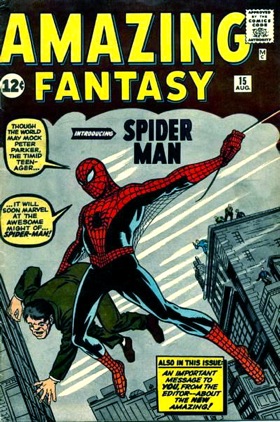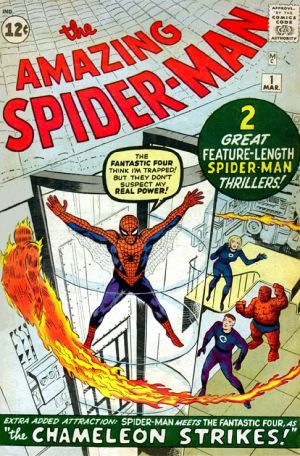Amazing Fantasy (1962) #15 at 50
By Andy Frisk
July 11, 2012 - 10:35
Marvel Comics
 |
It didn’t take long for Spider-Man, as portrayed in Amazing Fantasy (1962) #15, to get his own series: The Amazing Spider-Man (1963), It also didn’t take long for him to find widespread appeal, of all places, amongst college aged young adults of the 1960s. “In 1965, an Esquire magazine poll of college students ranked Spider-Man as one of their favorite revolutionary icons, along with Bob Dylan. Asked why, one interviewee reportedly picked Spider-Man because he was "beset by woes, money problems, and the question of existence. In short, he was one of us." (see quotation source here) I imagine this reaction to Spider-Man couldn’t have been more welcomed by Stan Lee. Stan the Man set out to create a superhero that was young, active, fallible, honest, good hearted, not a sidekick to an older hero a la Robin over at DC Comics, and most of all relatable to. Spider-Man was a kid without answers, real life problems, and the power to stand up to the elements of the system that were corrupt or unjust. Even more intelligently though, Spider-Man reflected the burgeoning movement to not just war against the system, but to use the system against itself to inspire change or at least change one’s station in life. Peter Parker, desperately trying to help his widowed Aunt May meet her financial needs, goes to work for J. Jonah Jameson, the publisher of one of the most anti-Spider-Man hate mongers in the Marvel U’s New York City, selling pictures of himself as Spider-Man and profiting off of them. He is using his talent as a photographer and as a superhero to care for his Aunt May honestly and thoughtfully. How easy would it be for someone like Peter Parker’s powers to set themselves up on easy street? No, the “great power/great responsibility” aspects of the character extended beyond just the super heroics. Life itself is full of opportunities to exercise great power for good or evil, and Peter decided to do it the hard way: the right and greatly responsible way.
 |
So much would Spider-Man appeal to this demographic that 50 years later, Amazing Fantasy (1962) #15 is still one of the modern age’s defining works of not only sequential art, but pop-art in general. Millions of kids still thrill to the animated and live action filmed adventures of Spider-Man on the both the small and big screens, while millions of adults, both young and old, continue to thrill to Spider-Man comic books, novels, and graphic novels. Here’s to another 50 years of The Amazing Spider-Man, his spectacular stories, and the lessons on responsibility that he reintroduces to each new generation.
Related Articles:
Skipping the Maximum Spider-Man
Live From New York, It’s Spider-Man
Spider-Man: Across the Spider-Verse
Spider-Man: No Way Home
Spider-Man Reign
How Sony Can Continue Tom Holland Spider-Man – Brand New Day
Generations: Miles Morales Spider-Man & Peter Parker Spider-Man #1 comics review
Bluefin Announces Samurai Spider-Man
Review: Amazing Spider-Man #4
The Amazing Spider-man #1.2
